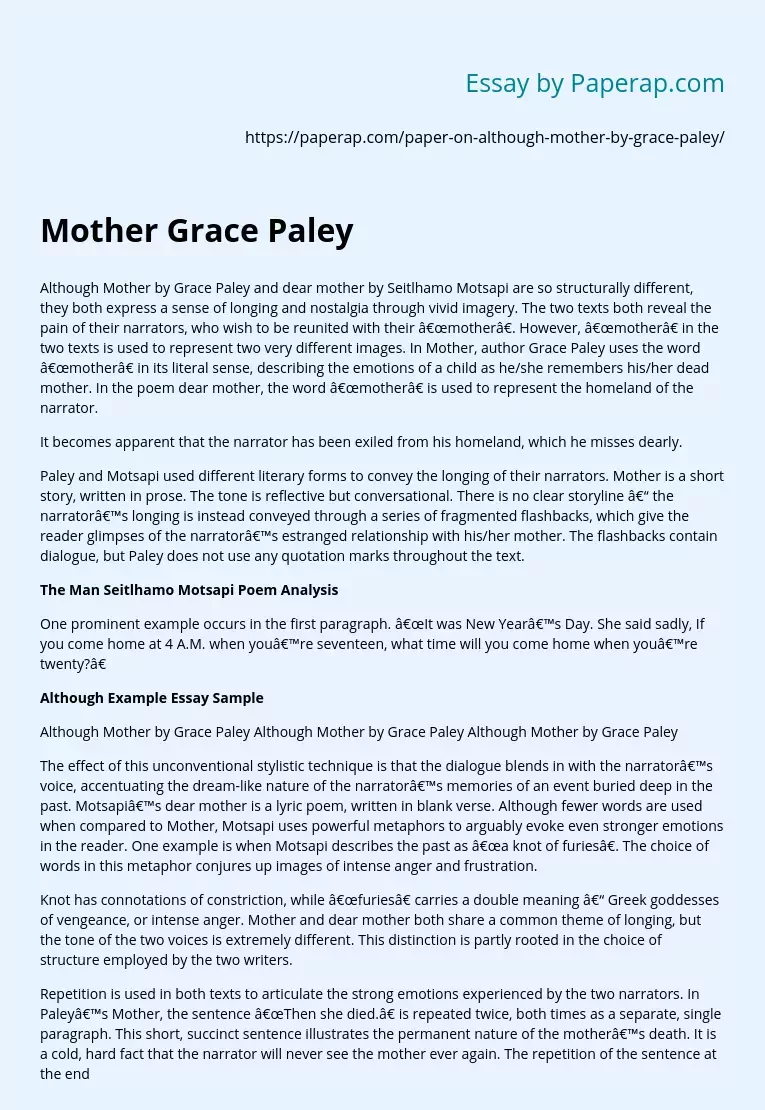Mother Grace Paley
Although Mother by Grace Paley and dear mother by Seitlhamo Motsapi are so structurally different, they both express a sense of longing and nostalgia through vivid imagery. The two texts both reveal the pain of their narrators, who wish to be reunited with their “mother”. However, “mother” in the two texts is used to represent two very different images. In Mother, author Grace Paley uses the word “mother” in its literal sense, describing the emotions of a child as he/she remembers his/her dead mother.
In the poem dear mother, the word “mother” is used to represent the homeland of the narrator.
It becomes apparent that the narrator has been exiled from his homeland, which he misses dearly.
Paley and Motsapi used different literary forms to convey the longing of their narrators. Mother is a short story, written in prose. The tone is reflective but conversational. There is no clear storyline – the narrator’s longing is instead conveyed through a series of fragmented flashbacks, which give the reader glimpses of the narrator’s estranged relationship with his/her mother.
The flashbacks contain dialogue, but Paley does not use any quotation marks throughout the text.
The Man Seitlhamo Motsapi Poem Analysis
One prominent example occurs in the first paragraph. “It was New Year’s Day. She said sadly, If you come home at 4 A.M. when you’re seventeen, what time will you come home when you’re twenty?”
Although Example Essay Sample
Although Mother by Grace Paley Although Mother by Grace Paley Although Mother by Grace Paley
The effect of this unconventional stylistic technique is that the dialogue blends in with the narrator’s voice, accentuating the dream-like nature of the narrator’s memories of an event buried deep in the past.
Motsapi’s dear mother is a lyric poem, written in blank verse. Although fewer words are used when compared to Mother, Motsapi uses powerful metaphors to arguably evoke even stronger emotions in the reader. One example is when Motsapi describes the past as “a knot of furies”. The choice of words in this metaphor conjures up images of intense anger and frustration.
Knot has connotations of constriction, while “furies” carries a double meaning – Greek goddesses of vengeance, or intense anger. Mother and dear mother both share a common theme of longing, but the tone of the two voices is extremely different. This distinction is partly rooted in the choice of structure employed by the two writers.
Repetition is used in both texts to articulate the strong emotions experienced by the two narrators. In Paley’s Mother, the sentence “Then she died.” is repeated twice, both times as a separate, single paragraph. This short, succinct sentence illustrates the permanent nature of the mother’s death. It is a cold, hard fact that the narrator will never see the mother ever again. The repetition of the sentence at the end of the text seems to reaffirm this reality.
These three simple words fully express the acceptance, regret and longing of the narrator. In Motsapi’s poem dear mother, repetition is used many times to heighten the emotional impact of the poem. Phrases such as “mother I lie awake at night” and “& so I cry to you mother” are repeated between stanzas. This gives the poem a rhythmic quality and effectively illustrates the raw desperation of the narrator. Common themes such as “night” and “cry” also recur throughout the poem.
These words evoke despair and distress, establishing the bitter tone of the poem and lending a feeling of continuity to the poem. The use of repetition to enhance the emotional impact of the central theme is a similarity that links the two otherwise very different texts.
Both Paley and Motsapi channel emotion into their texts through imagery, dipping into the rich resources of the senses to convey the longing of their personas. One clear example of imagery in the first paragraph of Mother paints a picture of the narrator’s memories. “She stood one day, just so, at the front door, the darkness of the hallway behind her.” As readers, we can clearly visualize the image of the mother in our mind, a beacon of light, fending off the endless darkness of the hallway behind her. The image of the mother silhouetted against a doorway is also profoundly symbolic, suggesting that with the mother’s death, the door between child and mother is forever closed. Unlike Mother the emotive imagery in dear mother is conveyed through a myriad of metaphors and similes which complement each other.
In conveying the pain of his persona, Motsapi writes: “my wounds distort the landscape of embraces my gait struggles like a lament” This example of imagery is as evocative as it is disturbing. The words “distort” and “lament” carry unique connotations that communicate the raw pain of the narrator, yearning to return to his homeland but unable to do so. Imagery is employed in different ways by the two writers. In Mother, descriptive imagery is used to evoke a more meaningful visual experience for the reader. In dear mother imagery takes the form of a fury of similes and metaphors, each one adding another layer of emotion to the text.
They may appear completely different at first glance, but Mother and dear mother both seek to recreate the universal emotion of longing. Where Mother uses the relationship between mother and child to communicate this emotion, dear mother uses the intrinsic connection between a man and his homeland, personified as a “mother”. Through their manipulation of language, we as readers can see that the two writers have interpreted “longing” in different ways. This is reflected in the tone of the two texts. Mother is reflective and whimsical, while dear mother is intertwined with hate and sorrow.
Mother Grace Paley. (2019, Dec 05). Retrieved from https://paperap.com/paper-on-although-mother-by-grace-paley/

